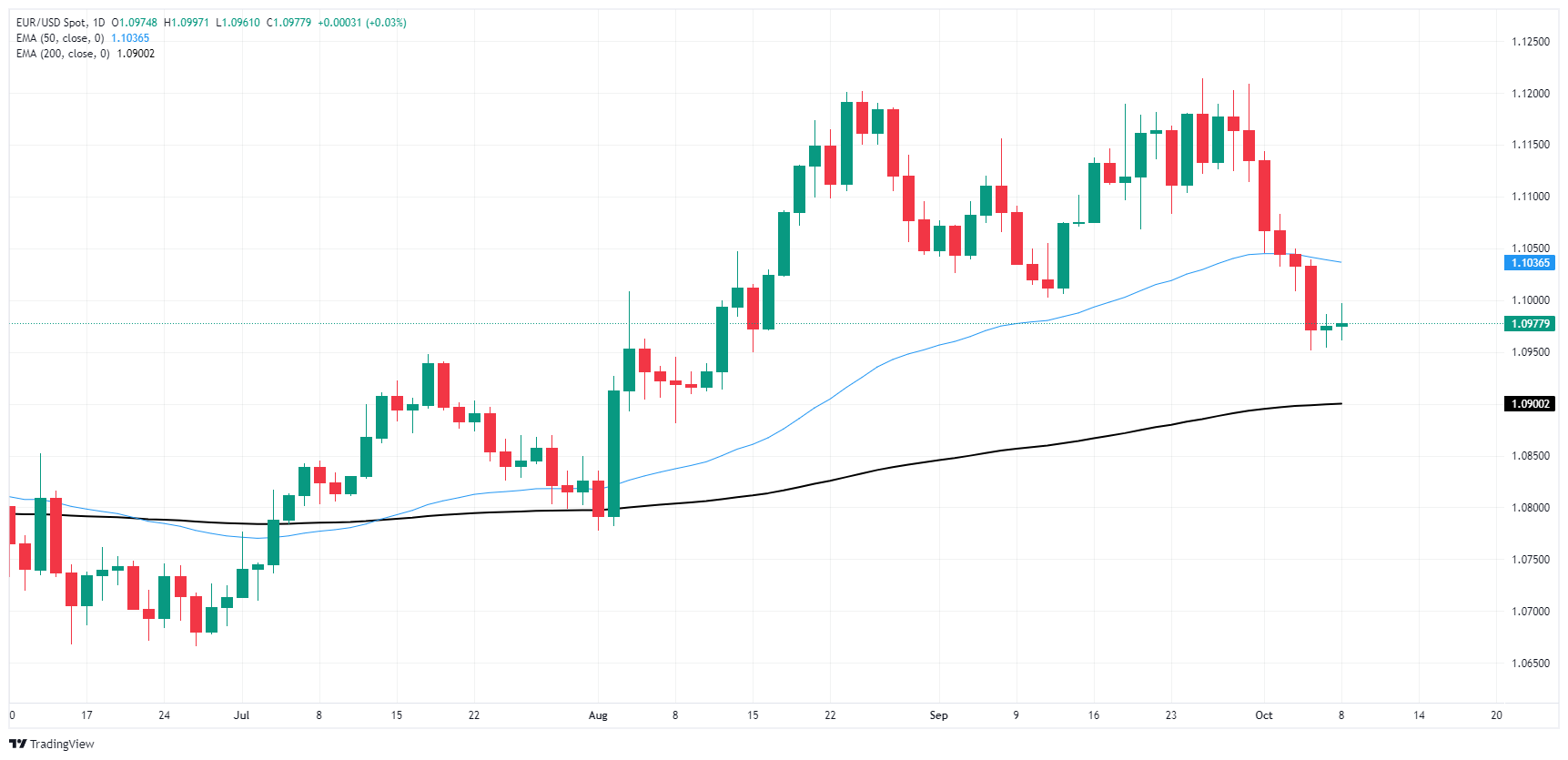- EUR/USD avoided further losses, but gains are still missing.
- The Fed meeting minutes will be released on Wednesday and will attract investors’ attention.
- Traders will be looking for good news in Thursday’s US CPI update.
EUR/USD was stable on Tuesday, failing to regain the 1.1000 zone but halting the Euro’s recent pullback from the 1.1200 region. The Euro has lost two-thirds of a percent against the US Dollar since hitting a one-year high in late September, falling back to the 1.0950 region as markets boost the Dollar across the board.
European data remains tepid for most of the trading week. The European Central Bank (ECB) is preparing for another rate decision next week, leaving the economic calendar largely free of pan-European data until then.
The latest Federal Reserve (Fed) meeting minutes on the September rate cut will be released on Wednesday, giving dollar traders plenty to analyze. Markets were widely expecting a double rate cut in November after the Fed opened the doors with a 50 bps cut in September. However, core inflation still remains above the Fed’s target levels and US jobs numbers came in well above expectations last week, which has firmly dampened hopes for rate cuts.
According to the CME’s FedWatch tool, rates markets see a nearly 90% chance that the Fed will follow September’s 50 bps cut with a more modest 25 bps cut on November 7. Fed officials have widely signaled that a weakening of the U.S. labor market would be required to push the Federal Reserve into larger rate cuts.
Additionally, another round of US inflation figures will be released on Thursday, with the release of the US Consumer Price Index (CPI) for September. US Core CPI is expected to decline to 0.2% MoM from 0.3% previously, while annualized headline CPI inflation is forecast to decline to 2.3% YoY from 2.5% previously.
EUR/USD Price Forecast
The Euro seems ready to enter a consolidation phase as the daily candlesticks set up a consolidation pattern. The pair is trading in the dead zone between the 50-day and 200-day exponential moving averages (EMA), but buyers are struggling to bounce back after EUR/USD’s collapse from north of the 1.1200 zone.
As long as sellers have lost momentum, Euro bulls will have nothing to fear from the 200-day EMA near 1.0900, while an extended bearish decline will send the Euro back to 2024 lows near 1.0600.
EUR/USD Daily Chart
The Euro FAQs
The Euro is the currency of the 20 countries of the European Union that belong to the euro zone. It is the second most traded currency in the world, behind the US dollar. In 2022, it accounted for 31% of all foreign exchange transactions, with an average daily volume of more than $2.2 trillion per day. EUR/USD is the most traded currency pair in the world, accounting for an estimated 30% of all transactions, followed by EUR/JPY (4%), EUR/GBP (3%) and EUR/AUD (2% ).
The European Central Bank (ECB), headquartered in Frankfurt, Germany, is the reserve bank of the euro zone. The ECB sets interest rates and manages monetary policy The ECB’s main mandate is to maintain price stability, which means controlling inflation or stimulating growth. Its main instrument is to raise or lower interest rates. Relatively high interest rates – or the expectation of higher rates – tend to benefit the Euro and vice versa. The Governing Council of the ECB takes monetary policy decisions at meetings held eight times a year. Decisions are made by the heads of the eurozone’s national banks and six permanent members, including ECB President Christine Lagarde.
Eurozone inflation data, measured by the Harmonized Index of Consumer Prices (HICP), are an important econometric data for the euro. If inflation rises more than expected, especially if it exceeds the 2% target set by the ECB, it is forced to raise interest rates to bring it back under control. Relatively high interest rates compared to their peers tend to benefit the Euro, as it makes the region more attractive as a place for global investors to park their money.
Data releases measure the health of the economy and can influence the Euro. Indicators such as GDP, manufacturing and services PMIs, employment and consumer sentiment surveys can influence the direction of the single currency. A strong economy is good for the Euro. Not only does it attract more foreign investment, but it may encourage the ECB to raise interest rates, which will directly strengthen the Euro. Conversely, if economic data is weak, the Euro is likely to fall. The economic data for the four largest economies in the eurozone (Germany, France, Italy and Spain) are especially significant, as they represent 75% of the eurozone economy.
Another important release for the euro is the trade balance. This indicator measures the difference between what a country earns from its exports and what it spends on imports during a given period. If a country produces highly sought-after export products, its currency will appreciate due to the additional demand created by foreign buyers wishing to purchase these goods. Therefore, a positive net trade balance strengthens a currency and vice versa for a negative balance.
Source: Fx Street
I am Joshua Winder, a senior-level journalist and editor at World Stock Market. I specialize in covering news related to the stock market and economic trends. With more than 8 years of experience in this field, I have become an expert in financial reporting.







